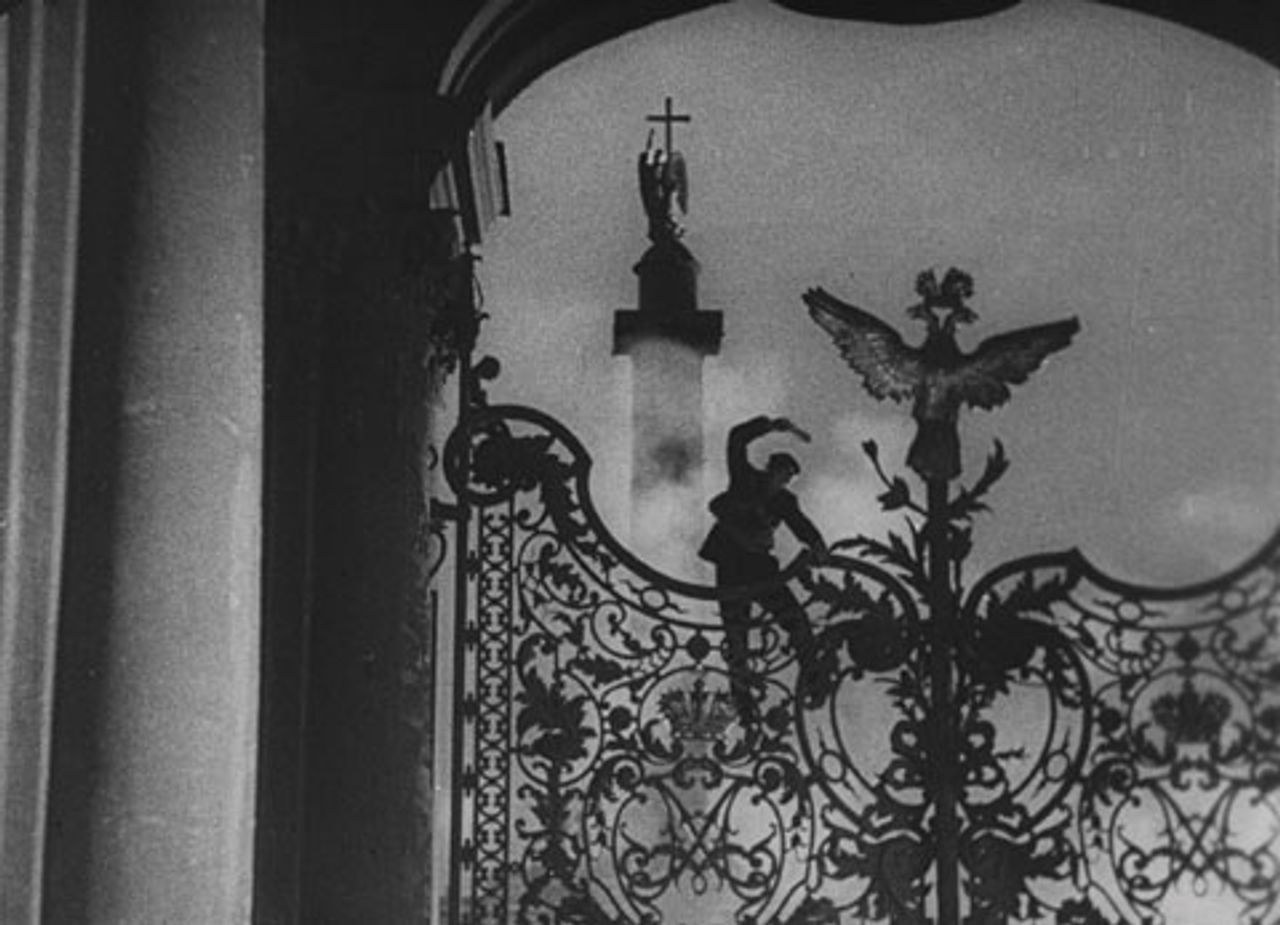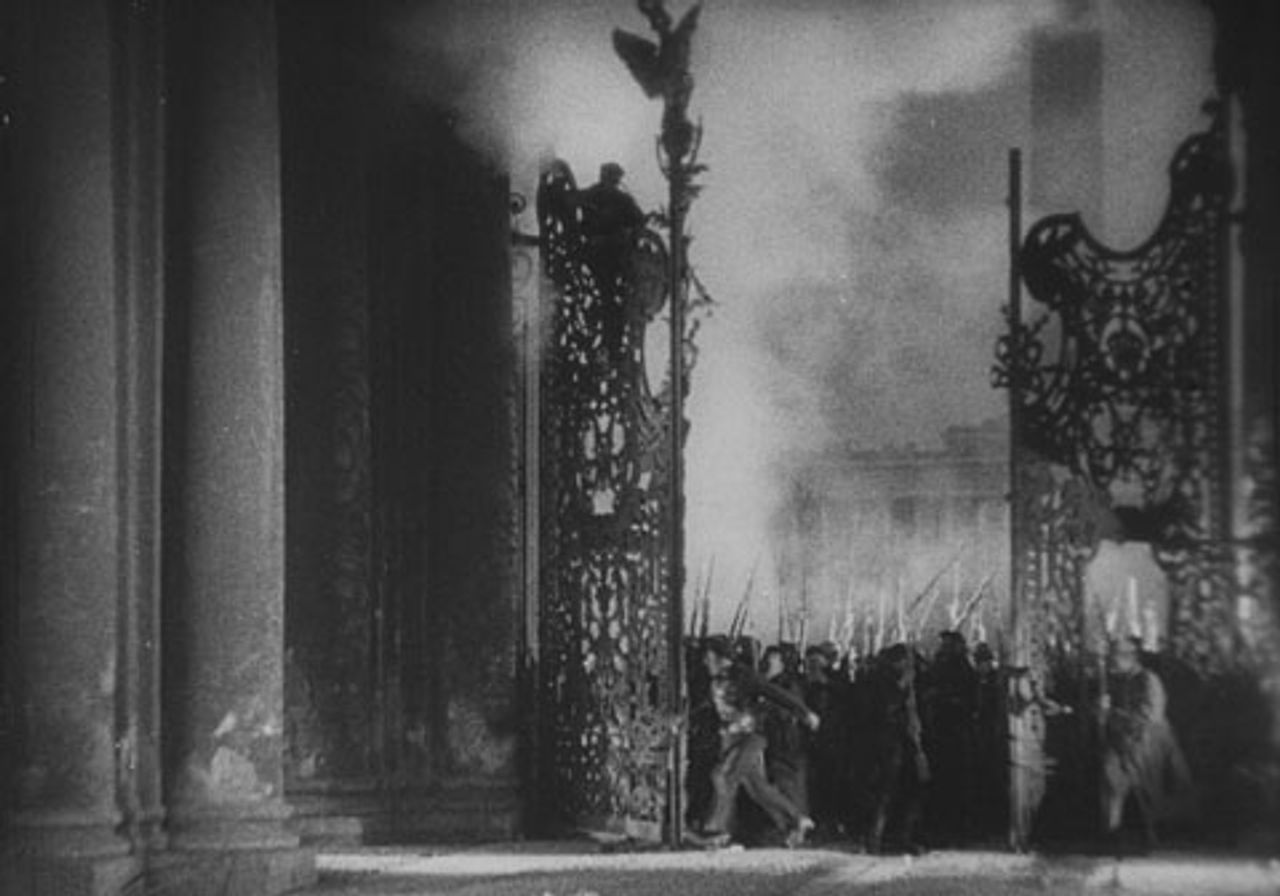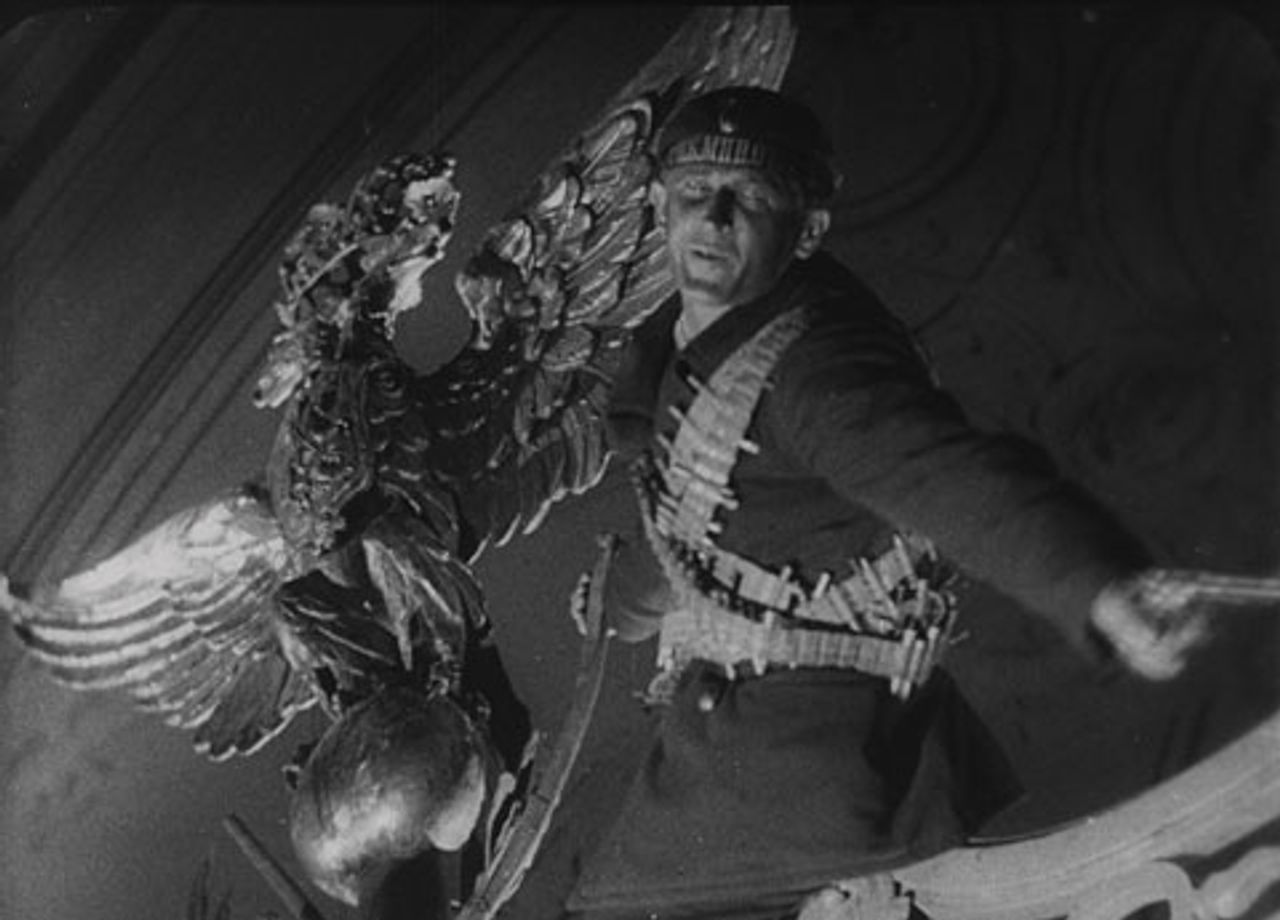This is the fourth of a series of articles on the recent Berlin film festival, the Berlinale, held February 9-19, 2012. Part 1 was posted February 24, Part 2 on February 29 and Part 3 on March 6.
 October
OctoberA new version of Sergei Eisenstein’s revolutionary classic October was given a special screening as part of this year’s Berlinale. It is the most complete reconstruction of the original film from 1928 and also featured for the first time music composed by Edmund Meisel for the German premiere of the film. Meisel had also composed the music for the German premiere of Battleship Potemkin (1925).
The Berlin Radio Symphony Orchestra played the accompanying music under the direction of Frank Strobel. Eisenstein’s images, combined with Meisel’s powerful rhythmic music, draw the viewer into a maelstrom. In some places the orchestra acts purely as a percussion instrument, effectively dissipating any impression of a musically aesthetic world of illusion. Nothing less than the revolution is on the march in this film.
In comparison to Eisenstein’s previous films, October makes a slightly weaker impact. From Strike (1925) onward, his crowd scenes always follow the same pattern. And even the impressive scene at the bridge contains motifs reminiscent of earlier films. Eisenstein was in the middle of work on The General Line (or Old and New, 1929), a new experimental film about the developments in the countryside, when he was commissioned by the government in 1926 to make a film on the 10th anniversary of the October Revolution.
Soviet society was undergoing fundamental political change. The defeats of the international labour movement in the 1920s strengthened the bureaucratic forces within the Soviet Communist Party and Communist International. The disputes culminated in expulsions from the Soviet party and the banishment of political opponents. In 1927, Trotsky was expelled from the party, and exiled from the Soviet Union in 1929.
 October
OctoberAccording to Oksana Bulgakowa’s biography of Eisenstein, the director originally planned a very comprehensive film, “featuring all the victories of the Red Army under Trotsky”. That is, it was to be a film covering the period of civil war and war communism. The plan was rejected and Eisenstein was advised to restrict himself to the events in Petrograd in 1917. The conception submitted by Eisenstein and his assistant, Grigori Alexandrov, had to be changed yet again. Asked by an American journalist who the author of the screenplay was, Eisenstein dryly replied, “the Party”.
On the evening of November 7, 1927, the unfinished film was to be screened at the Bolshoi Theatre for the first time. On the same day, a directive suddenly arrived, demanding that Trotsky be eliminated from the film. The reason given was that the Trotskyist opposition had held protest demonstrations in Moscow and Leningrad that morning. As Alexandrov recounts in his memoirs, Stalin himself came to Eisenstein’s editing room in the afternoon to view the film’s scenes involving Trotsky.
Eisenstein’s film was not shown that evening at the Bolshoi Theatre, but in the adjoining “experimental theatre”, presumably before a small audience. Only three episodes were allowed to be seen. Further changes were required. Two parts of the film had to be condensed into one. The public premiere at the Bolshoi was delayed until March 14, 1928, and was a failure with the audience. October was also adversely received in Berlin.
Contrary to what was generally expected, Eisenstein had not made a melodramatic, second attempt at Battleship Potemkin. October is full of humour and irony. Many viewers were irritated not only by the treatment of the Winter Palace’s baroque sculptures, which sometimes seem to comment ironically on the events. The film was found to be at times obscene and symbolically overloaded. It was condemned for its aestheticism and supposed incomprehensibility. Criticism came not only from the ranks of the Party, but also from artists. The reaction of the Left Front of the Arts (LEF) journal was so aggressive that Eisenstein broke from that group of avant-garde artists.
 October
OctoberNovel and irritating aspects of the film were certainly influenced by the real and often grotesque contradictions of post-revolutionary Soviet society. Unfortunately, October was never truly completed. Film historian Anna Bohn has suggested that the premiere version, despite the cuts already made, was still about 40 minutes longer than the present Russian film. The question of Eisenstein’s actual intentions is therefore difficult to reconstruct.
But one thing seems clear. The film intended to represent two revolutionary leaders, Lenin and Trotsky. Trotsky’s absence from the eventual film so obviously contradicts the historical record that one can only conclude the work was heavily censored. Trotsky was chairman of the Petrograd Soviet from September 25, 1917. However, the film does not show Trotsky, but another leader of the Petrograd Soviet, Yakov Sverdlov, exhorting soldiers with a rousing speech. An important episode in the film concerns the second All-Russian Congress of Soviets. This was of huge importance in relation to the debates actually taking place. Trotsky is missing from this part of the film. The program notes to October reveal that his “historic utterance, ‘Words must be followed by deeds’ are put into the mouth of a political companion”.
Eisenstein demonstrates his ability to use montage to portray anomalies of social and personal life through the characterisation of Aleksandr Kerensky, head of the bourgeois provisional government. The director strikingly depicts him as a “democrat”, who instinctively feels himself part of the aristocracy. A famous section of the film shows the door to the Tsar’s throne room opening and Kerensky entering it ... into the rear end of a mechanical peacock. By using several statues of Napoleon in a similarly humorous way, the film explores Kerensky’s inner spiritual kinship to General Lavr Kornilov, the tsarist officer leading the counterrevolution.
Had Eisenstein adopted a similar satirical manner to expose aberrations underlying certain key events of the revolution, leading figures in the party leadership would have fallen into disgrace. The victorious uprising was not a product of their efforts; in fact, the opposite was the case.
Until Lenin’s return from exile in April 1917, the party’s majority, including Stalin, had adopted a policy of critical support for Kerensky. Lenin rejected this and fought for the Bolsheviks to orient themselves toward the taking of power by the working class. Trotsky firmly supported this policy. Ultimately, in the fall of 1917, they urged an armed uprising. Bolshevik leaders Zinoviev and Kamenev were so opposed to the uprising that they were willing to use a Menshevik newspaper to circulate their ideas in public.
The cinematic account of the Bolshevik central committee meeting October 10 is most instructive. Trotsky briefly addresses the meeting. We view Lenin vigorously arguing for an uprising. Hands then go up and Lenin looks around the room with a searching, piercing glance. We are not informed that two members of the central committee, Kamenev and Zinoviev, voted against the uprising. Nor is it made clear that Trotsky vehemently supported the uprising. Later versions would not tolerate this “merely” indifferent rendering of Trotsky. The version produced by the future German Democratic Republic (GDR, East Germany) resolutely continues the tradition of Stalinist falsehood seeking to portray a conflict between the “opportunistic” Trotsky seeking to delay the uprising, and Lenin. Following Trotsky’s speech the GDR version includes the text that Trotsky favoured postponing the uprising.
As Trotsky writes in The History of the Russian Revolution, some of the original participants in the Revolution had already begun by 1926 to adapt their memories to the new political climate. But too many still knew how the events had really played out. Sitting in the USSR central executive presidium’s commission for the anniversary celebrations—i.e., in the body that monitored Eisenstein’s film—were activists who had taken part in the uprising. Some had offered themselves as performers in the film.
Among these were the former commanders Nikolai Podvoisky, head of the commission, and Vladimir Antonov-Ovseyenko. Stalin’s virtual absence from the film was not criticised because it corresponded to the facts. It was not until the coming of the Great Terror, waged against the old revolutionaries, that a sorry piece of film work such as Mikhail Romm’s Lenin in October (1937) could be made to present Stalin as a revolutionary leader. In 1938, the deadly wave engulfed Antonov-Ovseenko, who had been arrested by the Kerensky government in 1917.
The spirit of the “ten days that shook the world” is still alive in October. However, the restored version is also only a part of the whole monumental work, albeit a huge part. What a superb work might have been created if Eisenstein had been able to realise his original plans! The storm of 1917 would have formed merely the introduction.
The self-serving bureaucracy had no need for Eisenstein’s sparkling irreverent imagination, his wealth of innovative ideas. It was not interested in the revolution, and certainly not world revolution, as propagated at the end of October. The socialist revolution in China had just been crushed, the Stalinists having sabotaged it.
One day after the premiere of October, a party conference was initiated to discuss “Questions arising from the film”. This marked the beginning of the campaign against so-called formalism. October was banned—for the next nearly 40 years. One wonders how many of the actual participants in the revolution would have been edited out of the film over that time.
In a thoroughly cynical exercise, photo stills from Eisenstein’s storming of the Winter Palace, staged in epic fashion, were hung in the USSR’s museums of the revolution as if they were “historical photographs”.
